Georgia O'Keeffe (1887-1986) is considered a major painter across the Atlantic: and for good reason, she's a monument of Modern American Art. The great popularity of Georgia O'Keeffe is due as much to the work as to the extraordinary personality of this woman. However, nothing predestined her for an artistic future, and especially not her family cocoon.
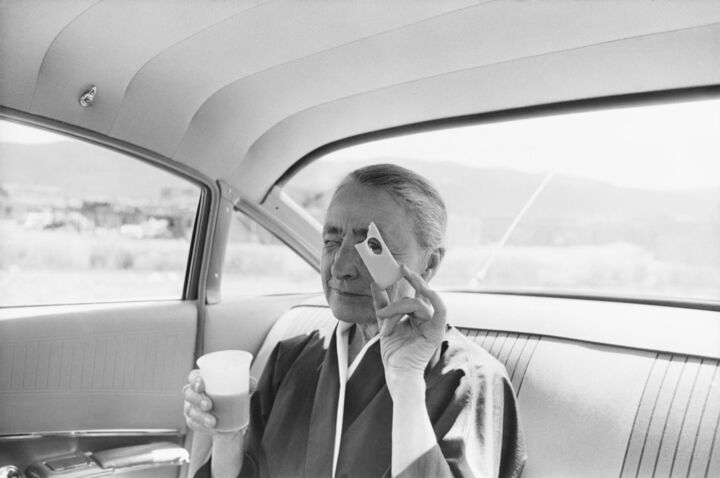
Tony Vaccaro, Georgia O’Keeffe with the Cheese, 1960.
1. A Destiny Drawn Against All Odds
Georgia O'Keeffe grew up in the Middle West, in the heart of the vast prairies (Wisconsin). Born into a relatively poor farming family in 1887, she lived until the age of 12 with her six brothers and sisters, harvesting and plowing. Very early on, she showed a real interest in plastic activities, and enrolled in drawing classes with her younger sister. She was only 12 years old, but she already knew her vocation: she would be an artist. At the age of 17, she began her artistic studies at the Art Institute of Chicago, then at the Art Student League of New York, the most prestigious institution of the time.
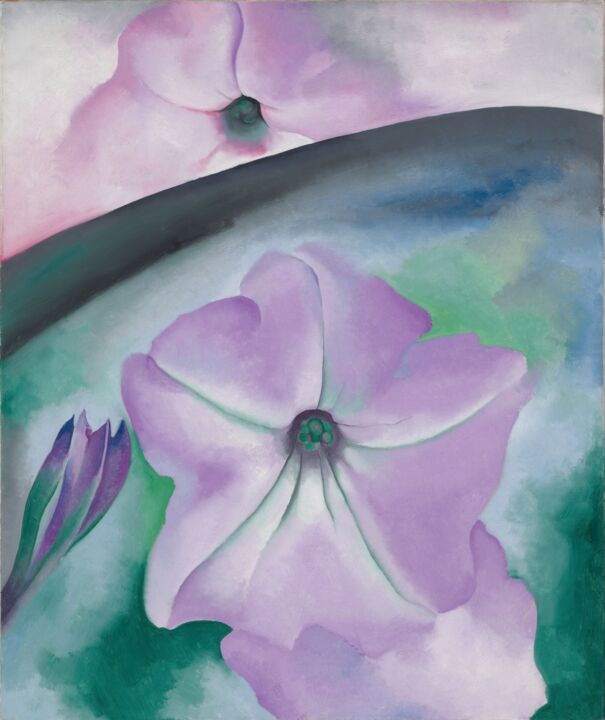
Georgia O’Keeffe, Petunia N°2, 1924.
Despite this fine example of perseverance facing the tyranny of social reproduction, other obstacles unfortunately interfered with her path to success. In 1908, Georgia had to stop her studies because her family could no longer afford to finance her education. Without a diploma, she survived for 8 long years in a situation of intense precariousness, alternating between occasional missions in the advertising sector or in teaching drawing.

Georgia O’Keeffe, captured by Alfred Stieglitz in 1918.
It was during this time that she discovered Texas, its warm light and its arid lands, which would fascinate her all her life. Fortunately, she didn't give up her artistic ambitions and decided to register in 1916 at the Teacher College of Columbia (New York), to obtain a teaching degree, the Holy Grail that would allow her to reach a more stable situation. Unfortunately, she didn't obtain this degree, but she met two people there, who would be decisive for her career.
2. Solitude, Friendship and Love
Georgia O'Keeffe was a rather introverted personality: she didn't hate human contact, far from it, but she treasured solitude, oscillating her free time (when she wasn't painting) between meditative introspection and contemplative walks. Yet it was through her few connections that she achieved the success she is now known for.

Georgia O’Keeffe, Ram’s Head, Blue Morning Glory, 1938.
In 1916, her friend Anita Pollitzer (whom she had met at Columbia's Teacher College) brought a notebook of Georgia's drawings to Gallery 291 on Fifth Avenue in New York. This gallery was the only exhibition space available to painters of the American avant-garde. Held by photographer Alfred Stieglitz, it featured works by Rodin, Cézanne, Matisse or Picasso, as well as a host of other fiery and revolutionary artists who were still unknown to the general public, especially in the US.
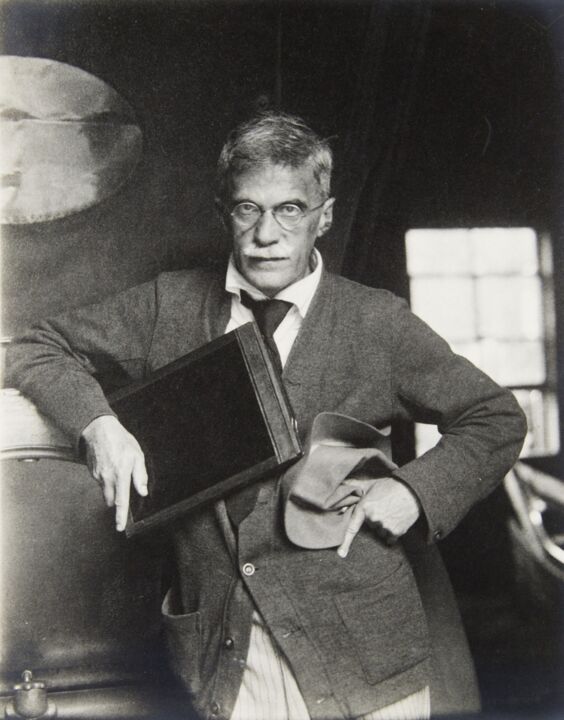
Alfred Stieglitz, captured by Paul Strand in 1917.
Alfred Stieglitz quickly fell under the spell of these drawings. For him, these pictures are "the purest, most beautiful and honest images that have reached the 291 for a long time".
He therefore decided to display these works, without the artist's knowledge. When Georgia O'Keeffe discovered her drawings by chance in the gallery's display cases, she was initially furious and asked Stieglitz to remove them immediately from his walls. However, these two cultured personalities, deeply devoted to art, quickly became attracted to each other. They began a letter-writing relationship that would lead to a strong bond, as fusional as it was conflicting.

Georgia O’Keeffe, Special N°22, 1916-1917.
3. An Organic Work
Her gallerist, friend and lover Alfred Stieglitz was quick to defend her, more vehemently than the other artists he represented. Georgia knew that this was an unhoped-for boost to her confidence: she could finally devote herself to her passion, painting. In 1918, she moved to New York and spent her days developing her own particular style.
Inspired by the work of the painter Arthur W. Dow, her paintings are based on a rigorous ordering of various elements: colors, shapes, lines, volumes and spaces are used to create a new kind of figurative compositions.
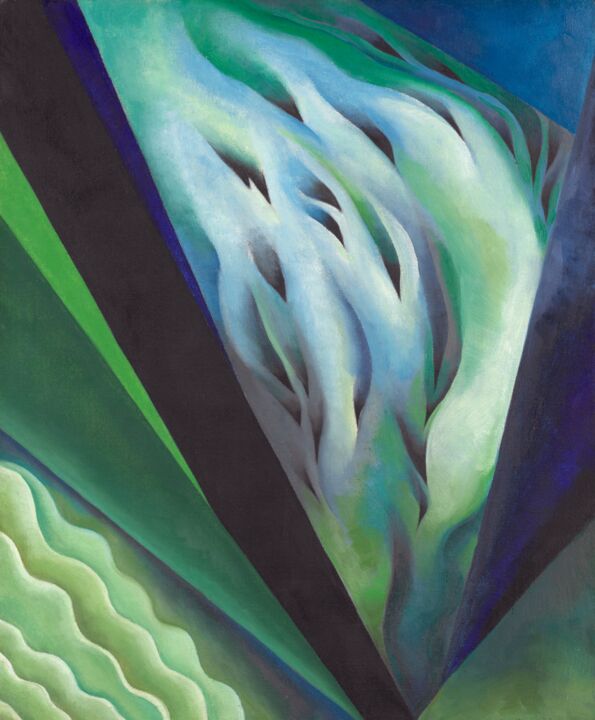
Georgia O’Keeffe, Blue and Green Music, 1919-1921.
Her paintings and her vision of the world are organic. Georgia O'Keeffe found her way: she was inspired by the urban climate of New York to create a series of works centered on the denatured nature, then quickly returned to her first impulse: depicting nature through the prism of her sensations. Flowers, sky, mountains, skulls and animal bones become his creative fuel and his trademark. Plant forms blossom on his canvases, and are confronted with a particular rhythm. The close-up flowers, emblematic of Georgia O'Keeffe's art, are like organic spectres, on the border between traditional figurative art and the lyrical abstraction developed by Kandinsky.

Georgia O’Keeffe, Pink Dish and Green Leaves, 1928.
4. New-Mexico: An Eldorado of Inspiration
At the end of the 1920s, Georgia had to undergo various medical operations. At the same time, her private life began to decline: Alfred Stieglitz was interested in another woman. She decided to take flight and devote herself fully to the development of her professional career.
In 1929, Georgia O'Keeffe discovered the region of New Mexico, and quickly fell in love with its arid and luminous climate, which radiates landscapes of a divine light. She finally found the wide open spaces she had known as a child and during her stay in Texas.
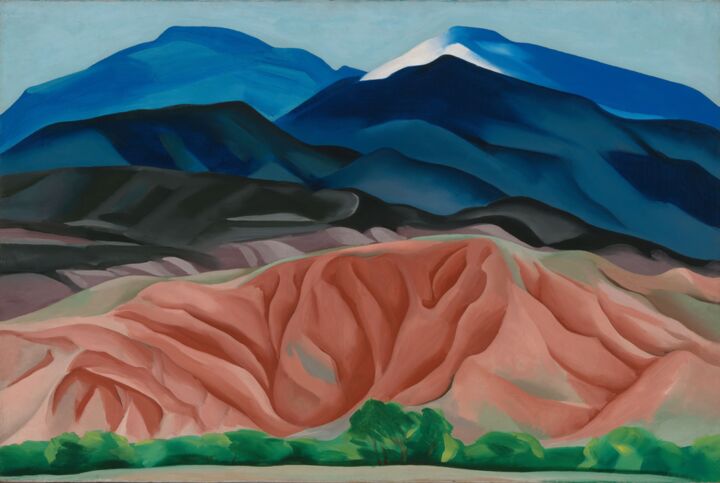
Georgia O’Keeffe, Black Mesa Landscape (New Mexico), 1930.
Little by little, the artist made her nest: first she rented a house for the vacations, then in 1934, to satisfy her insatiable need for peace and solitude, she decided to settle there for long. At first she lived in an old isolated farmhouse, the Ghost Ranch, and then in 1940 she bought the Rancho de los Burros, which offered her an extraordinary view of the red cliffs of the valley.

Georgia O’Keeffe, The House I Live In, 1937. Yale Museum.
Georgia O'Keeffe's art is always an immediate response to her surroundings. From that time on, she created compositions closely related to her daily life: the desert plains, the barren mountains, the door of her patio...
Amazed by nature, she collects skulls and bones during her walks. These will serve as models for her artworks. For her, these bones are memories of the living. She refuses to have a macabre vision of them, but prefers to see a symbolic approach to the aesthetics of death and therefore, of life. The idea of combining these skulls with colored flowers gives some of her paintings an unreal atmosphere, bordering on the mystical.
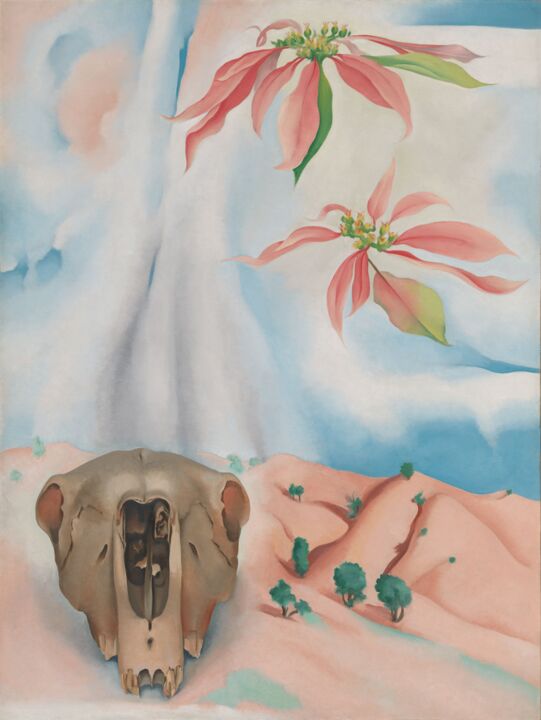
Georgia O’Keeffe, Mule’s Skull with Pink Poinsettias, 1936.
5. Nature's Eroticization: An Overly Masculine Interpretation of her work?
Today, as in the past, Georgia O'Keeffe's work is appreciated for the many mischievous sensual (or sexual) connotations that can be detected in some of her organic compositions. Some see phallic or vulval forms, while some of her mountain landscapes are regularly compared to Gustave Courbet's genial and impudent Origin of the World.

Georgia O’Keeffe, Serie I – White and Blue Flower Shapes, 1919.
However, this erotic reading has never been validated by the artist herself: so, misunderstanding or bad faith? Well, as is often the case, it's mainly a particular context that explains this astonishing situation. At the time - and this is still true today - we are talking about a woman artist, accomplished and independent, whose work is analyzed by a bunch of white, wealthy, cultured and elitist men. These Art Critics will apply a very gendered reading of her creations, even going so far as to transpose their own phantasms into Georgia O'Keeffe's compositions.

Georgia O’Keeffe, Red Hills with the Pedernal, 1936.
It's mostly a misunderstanding maintained by time. When Georgia produced her first successful paintings, Europe saw the rise of a new science: psychoanalysis, theorized by the famous Sigmund Freud. Freudian theories quickly crossed the Atlantic and reached the educated elite in need of painful introspection. Georgia O'Keeffe's work was analyzed according to these recent theories that fascinated the establishment: for the Art Critics, all men, Georgia's paintings were proof, examples of feminine thought, of a woman who "saw the world through her womb". For them, Georgia's drawings are feminine impulses put down on paper.
Obviously, the misreading of her work will do much harm to Georgia O'Keeffe: it caused first a severe depression, then a kind of self-censorship as to the themes she would like to treat. She quickly abandoned her abstract expressions and devoted herself to figurative painting, hoping to get around the misleading analysis of her paintings.

Georgia O’Keeffe, Head in a Broken Pot, 1943.
6. An American Legend
Today, Georgia O'Keeffe is an eternal legend. An essential link in the development of art in the United States and a symbol of committed feminism, she embodies the American spirit of the great outdoors through her independence and her fascinating originality.
She became a role model for a whole generation of women and feminist artists, such as Judy Chicago (who paid tribute to her in the masterpiece The Dinner Party) or Barbara Kruger. She's also well integrated in Pop Culture (especially in America), and tributes to her work have multiplied in recent years: The Simpsons, Family Guy, Big Eyes (Tim Burton) or even the huge critical success Breaking Bad have made more or less extensive references to her work and life to symbolize both the American spirit and female independence (or simply to humorously return to the confusion caused by some of her paintings).
Georgia O'Keeffe is a unique artist. Her unclassifiable work borrows from landscapes, romanticism, minimalism, orientalism and political art. An icon of artistic and feminist emancipation, she was a true fighter for the liberation of forms and women. Her powerful, inspiring and uncompromising art will mark the history of art forever: Thanks Georgia!


 Bastien Alleaume (Crapsule Project)
Bastien Alleaume (Crapsule Project)